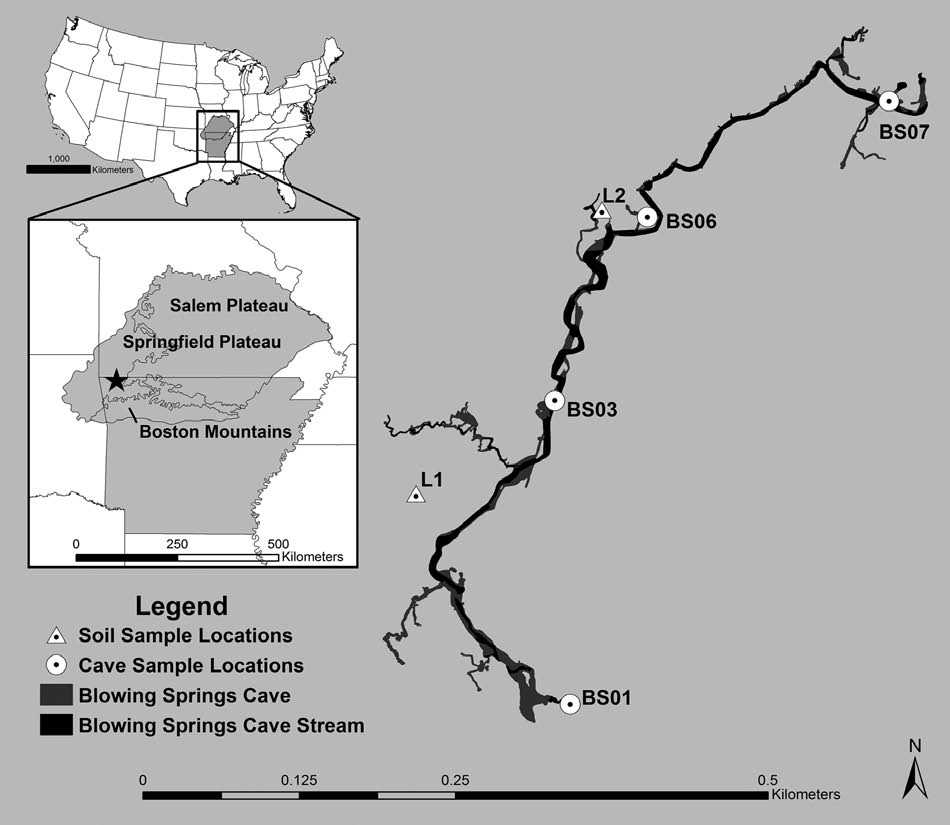Using isotopes of dissolved inorganic carbon species and water to separate sources of recharge in a cave spring, northwestern Arkansas, USA Blowing Spring Cave
DOI:
https://doi.org/10.3986/ac.v42i2-3.667Keywords:
carbon, stable isotopes, cave, hydrograph, ArkansasAbstract
Blowing Spring Cave in northwestern Arkansas is representative of cave systems in the karst of the Ozark Plateaus, and stable isotopes of water (δ18O and δ2H) and inorganic carbon (δ13C) were used to quantify soil-water, bedrock-matrix water, and precipitation contributions to cave-spring flow during storm events to understand controls on cave water quality. Water samples from recharge-zone soils and the cave were collected from March to May 2012 to implement a multicomponent hydrograph separation approach using δ18O and δ2H of water and dissolved inorganic carbon (δ13C–DIC). During baseflow, median δ2H and δ18O compositions were –41.6‰ and –6.2‰ for soil water and were –37.2‰ and –5.9‰ for cave water, respectively. Median DIC concentrations for soil and cave waters were 1.8 mg/L and 25.0 mg/L, respectively, and median δ13C–DIC compositions were –19.9‰ and –14.3‰, respectively. During a March storm event, 12.2 cm of precipitation fell over 82 h and discharge increased from 0.01 to 0.59 m3/s. The isotopic composition of precipitation varied throughout the storm event because of rainout, a change of 50‰ and 10‰ for δ2H and δ18O was observed, respectively. Although, at the spring, δ2H and δ18O only changed by approximately 3‰ and 1‰, respectively. The isotopic compositions of precipitation and pre-event (i.e., soil and bedrock matrix) water were isotopically similar and the two-component hydrograph separation was inaccurate, either overestimating (>100%) or underestimating (<0%) the precipitation contribution to the spring. During the storm event, spring DIC and δ13C–DIC decreased to a minimum of 8.6 mg/L and –16.2‰, respectively. If the contribution from precipitation was assumed to be zero, soil water was found to contribute between 23 to 72% of the total volume of discharge. Although the assumption of negligible contributions from precipitation is unrealistic, especially in karst systems where rapid flow through conduits occurs, the hydrograph separation using inorganic carbon highlights the importance of considering vadose-zone soil water when analyzing storm chemohydrographs.
Keywords: carbon, stable isotopes, cave, hydrograph, Arkansas.
Downloads

Downloads
Published
How to Cite
Issue
Section
License
Authors guarantee that the work is their own original creation and does not infringe any statutory or common-law copyright or any proprietary right of any third party. In case of claims by third parties, authors commit their self to defend the interests of the publisher, and shall cover any potential costs.
More in: Submission chapter




